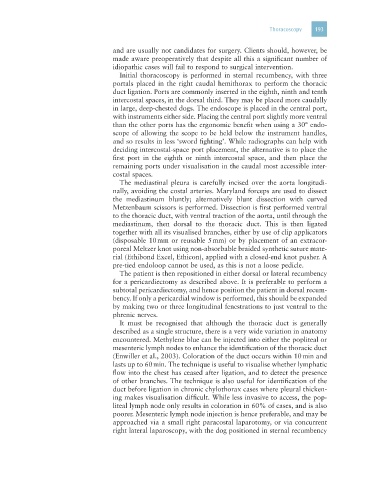Page 205 - Clinical Manual of Small Animal Endosurgery
P. 205
Thoracoscopy 193
and are usually not candidates for surgery. Clients should, however, be
made aware preoperatively that despite all this a significant number of
idiopathic cases will fail to respond to surgical intervention.
Initial thoracoscopy is performed in sternal recumbency, with three
portals placed in the right caudal hemithorax to perform the thoracic
duct ligation. Ports are commonly inserted in the eighth, ninth and tenth
intercostal spaces, in the dorsal third. They may be placed more caudally
in large, deep-chested dogs. The endoscope is placed in the central port,
with instruments either side. Placing the central port slightly more ventral
than the other ports has the ergonomic benefit when using a 30° endo-
scope of allowing the scope to be held below the instrument handles,
and so results in less ‘sword fighting’. While radiographs can help with
deciding intercostal-space port placement, the alternative is to place the
first port in the eighth or ninth intercostal space, and then place the
remaining ports under visualisation in the caudal most accessible inter-
costal spaces.
The mediastinal pleura is carefully incised over the aorta longitudi-
nally, avoiding the costal arteries. Maryland forceps are used to dissect
the mediastinum bluntly; alternatively blunt dissection with curved
Metzenbaum scissors is performed. Dissection is first performed ventral
to the thoracic duct, with ventral traction of the aorta, until through the
mediastinum, then dorsal to the thoracic duct. This is then ligated
together with all its visualised branches, either by use of clip applicators
(disposable 10 mm or reusable 5 mm) or by placement of an extracor-
poreal Meltzer knot using non-absorbable braided synthetic suture mate-
rial (Ethibond Excel, Ethicon), applied with a closed-end knot pusher. A
pre-tied endoloop cannot be used, as this is not a loose pedicle.
The patient is then repositioned in either dorsal or lateral recumbency
for a pericardiectomy as described above. It is preferable to perform a
subtotal pericardiectomy, and hence position the patient in dorsal recum-
bency. If only a pericardial window is performed, this should be expanded
by making two or three longitudinal fenestrations to just ventral to the
phrenic nerves.
It must be recognised that although the thoracic duct is generally
described as a single structure, there is a very wide variation in anatomy
encountered. Methylene blue can be injected into either the popliteal or
mesenteric lymph nodes to enhance the identification of the thoracic duct
(Enwiller et al., 2003). Coloration of the duct occurs within 10 min and
lasts up to 60 min. The technique is useful to visualise whether lymphatic
flow into the chest has ceased after ligation, and to detect the presence
of other branches. The technique is also useful for identification of the
duct before ligation in chronic chylothorax cases where pleural thicken-
ing makes visualisation difficult. While less invasive to access, the pop-
liteal lymph node only results in coloration in 60% of cases, and is also
poorer. Mesenteric lymph node injection is hence preferable, and may be
approached via a small right paracostal laparotomy, or via concurrent
right lateral laparoscopy, with the dog positioned in sternal recumbency

